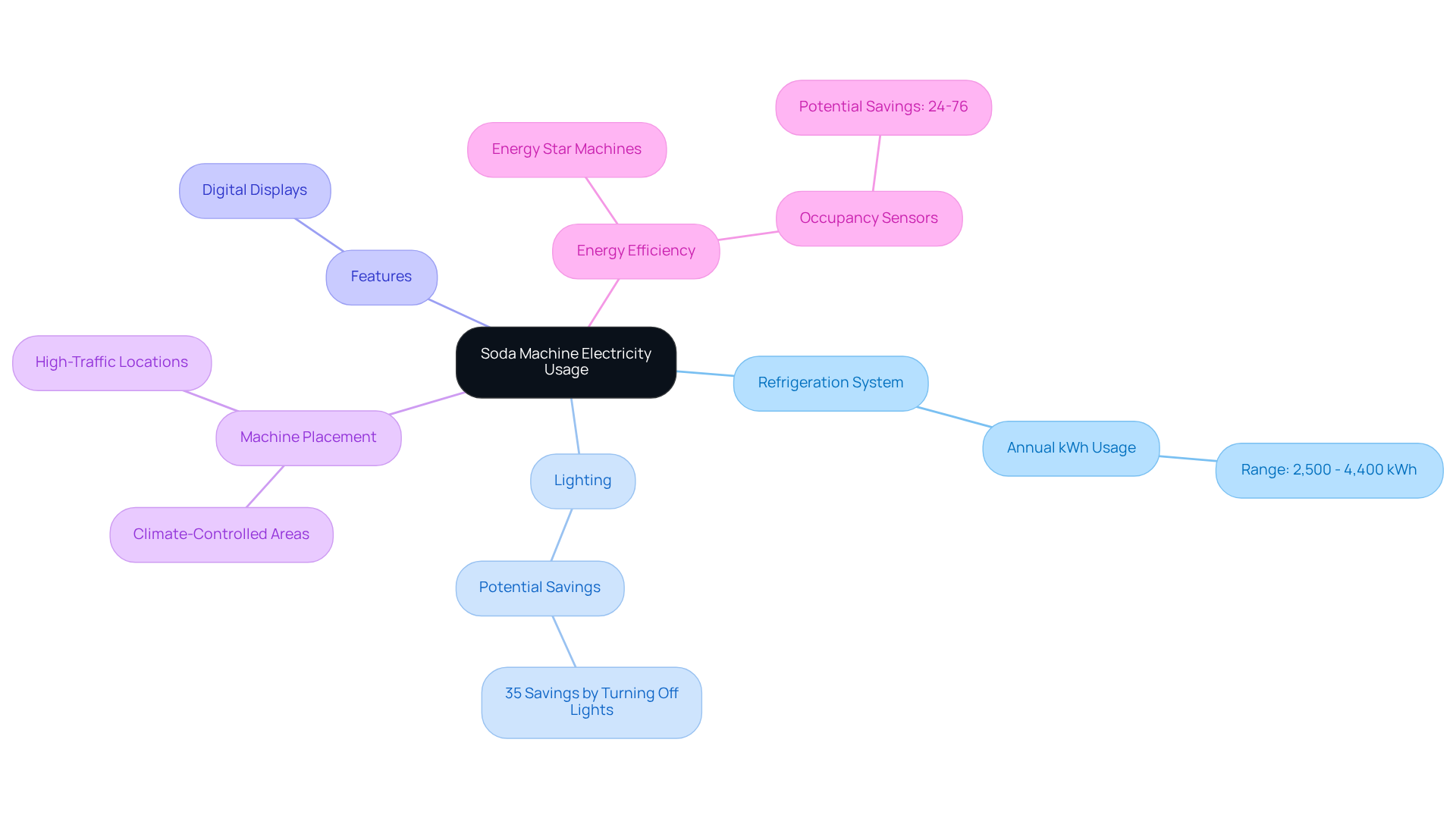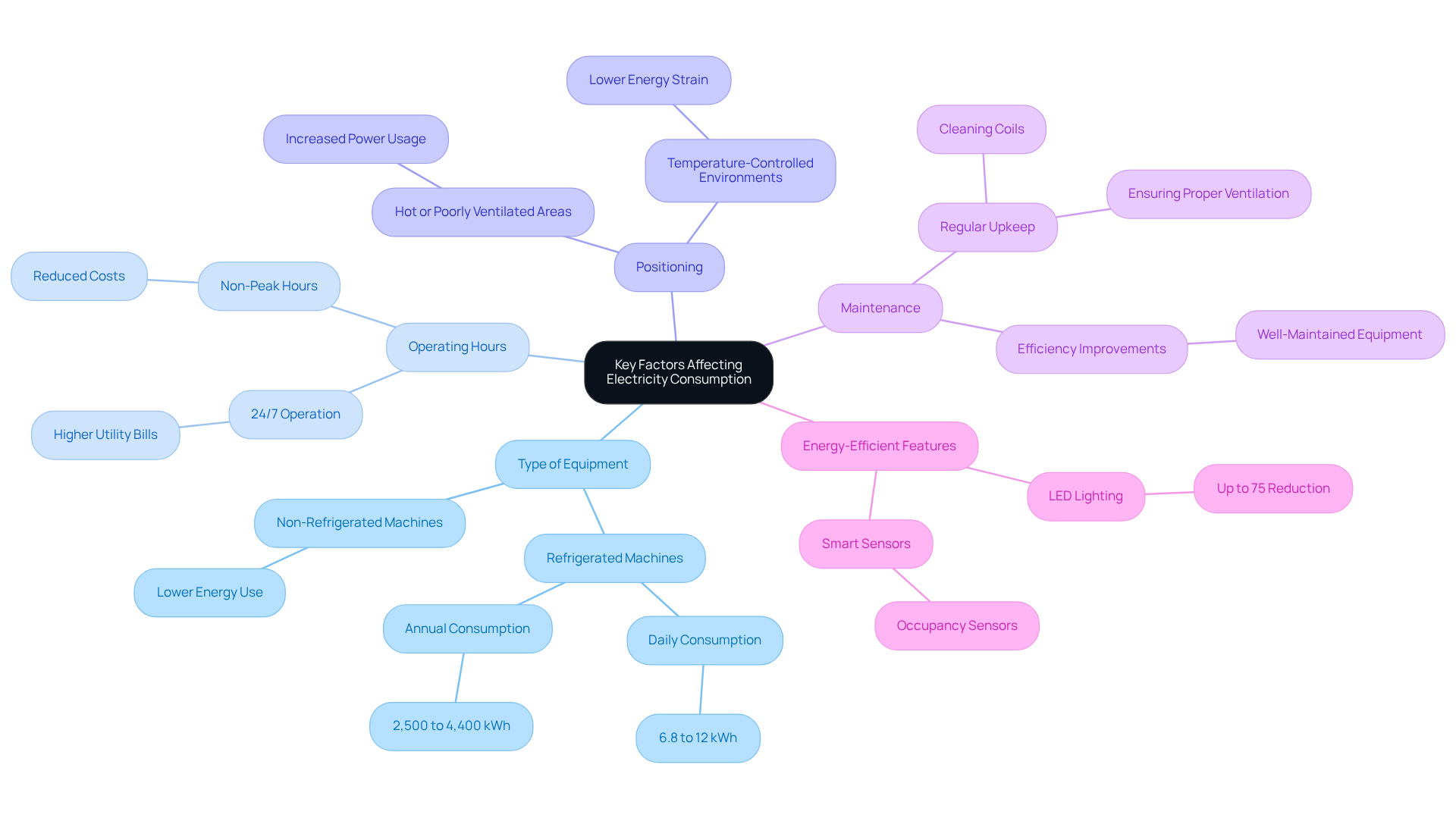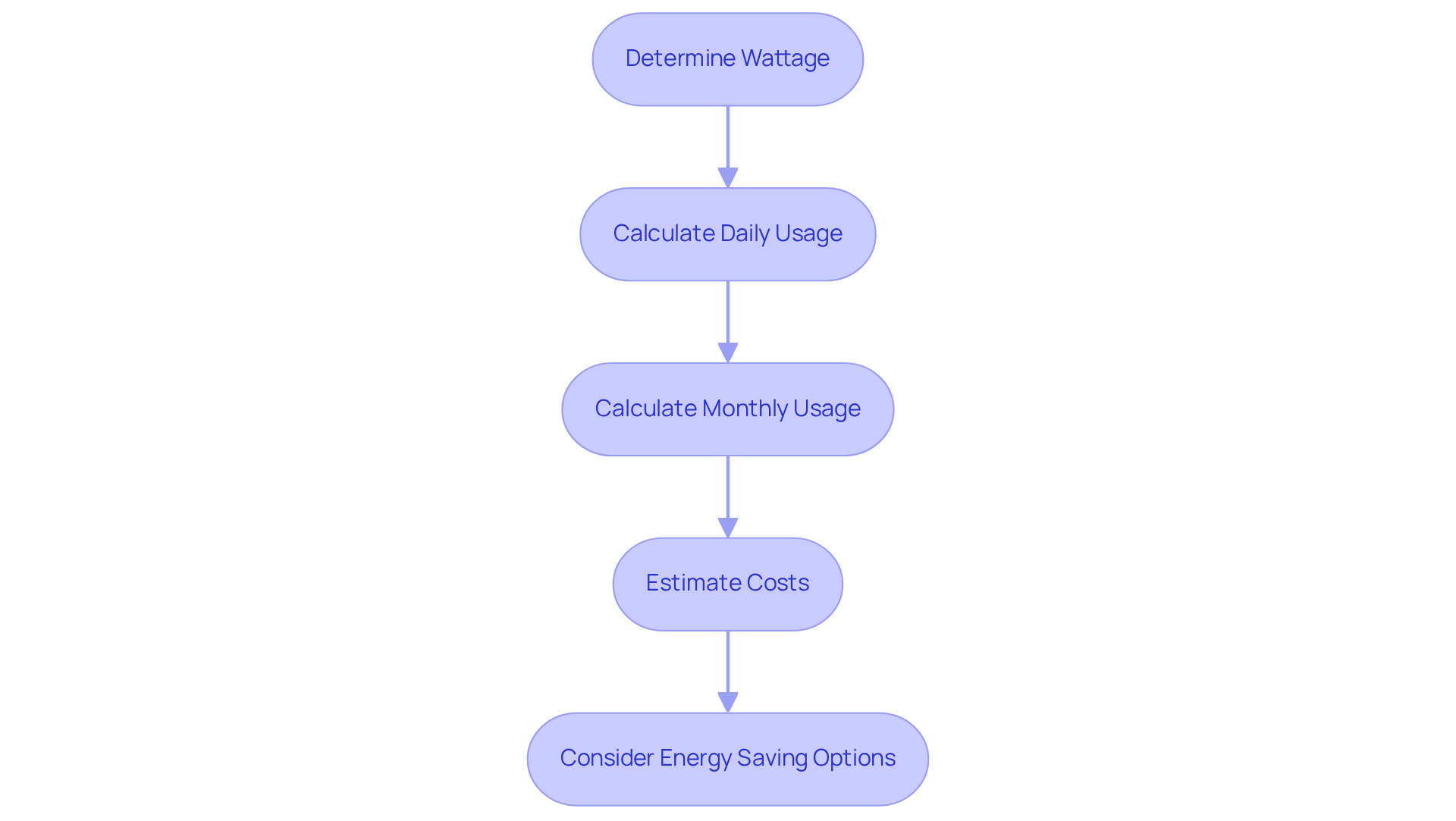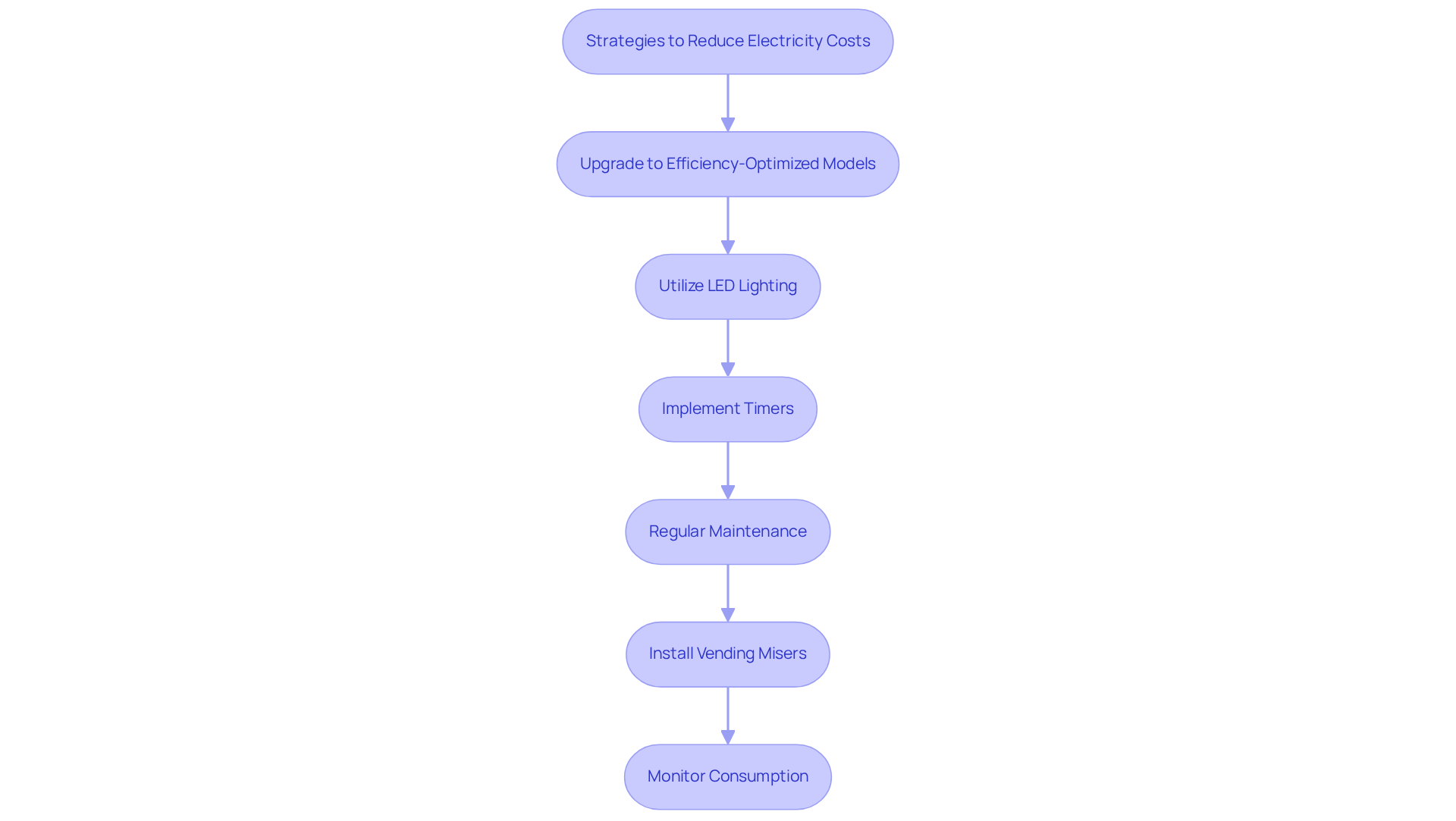Overview
Ever thought about how much energy those soda machines really use? They typically guzzle between 2,500 to 4,400 kilowatt-hours (kWh) each year! A big chunk of that comes from their refrigeration systems and how they’re used.
Here’s the thing: factors like the type of machine, how often it’s used, where it’s placed, and how well it’s maintained can really affect that energy bill. But the good news is, there’s potential for savings!
By switching to energy-efficient models and adopting smart operational strategies, you can cut down on energy costs. So, why not take a closer look at your soda machine setup? It could be a simple way to save some cash and help the environment, too!
Introduction
Did you know that soda machines can really impact your electricity bills? It’s true! These vending units, which might seem harmless, actually consume quite a bit of energy. With annual usage between 2,500 and 4,400 kilowatt-hours, it’s clear that what type of machine you have and how it’s operated can make a big difference.
So, how do you balance convenience with sustainability? That’s where the challenge lies. As a business owner, you want to keep things running smoothly without breaking the bank. But the good news is, there are practical steps you can take to enhance efficiency and cut those costs.
In this article, we’ll dive into the nitty-gritty of soda machine electricity usage. We’ll share some straightforward strategies that can help you save money while still providing great service. Let’s break it down together!
Understand the Basics of Soda Machine Electricity Usage
Soda dispensers, especially the refrigerated ones, can really increase how much electricity does a soda machine use, leading to a higher electricity bill. They typically use between 2,500 to 4,400 kilowatt-hours (kWh) each year, illustrating how much electricity does a soda machine use. Why such a big range? Well, it all comes down to the equipment and depending on how often it's used.
Here's the thing: the refrigeration system is a major player here, constantly working to keep those drinks nice and cold, and it makes me wonder how much electricity does a soda machine use. And don’t forget about the lighting — that can take a big bite out of your energy consumption too. For instance, if you turn off the lights on a vending machine, you could cut power usage by up to 35 percent! Pretty significant, right?
Now, features like digital displays can add to the power needs, so it’s good to be aware of that. Understanding these factors is key to managing your utility costs and boosting your vending operations, particularly by considering how much electricity does a soda machine use, especially in locations that might sit empty during the evenings and weekends. That’s where you can really save.
So, what can you do? Consider looking into Energy Star vending machines to find out how much electricity does a soda machine use or the most efficient models available. They can really help with energy consumption. And if you use occupancy sensors, you might save anywhere from 24 to 76 percent, depending on how often the machines are used.
Also, placing your machines in climate-controlled areas can boost their efficiency. Remember, higher room temperatures can make compressors work harder, which means more energy used.
Overall, by keeping these points in mind, you can make smart choices that not only align with sustainability goals but also help cut down on those operational costs. Let’s make your vending game as efficient as possible!

Identify Key Factors Affecting Electricity Consumption
Understanding how much electricity does a soda machine use can help you manage costs, as electricity consumption in soda vending machines can be a bit of a puzzle.
First off, let’s talk about the type of equipment. Refrigerated units? They’re energy hogs compared to non-refrigerated ones. A typical refrigerated soda dispenser can use anywhere from 6.8 to 12 kWh daily, leading to the question of how much electricity does a soda machine use, particularly with those higher-end models.
Now, consider your operating hours. Machines running 24/7 are going to rack up higher utility bills than those that get turned off during non-peak times. This constant operation raises concerns about how much electricity does a soda machine use, potentially leading to annual electricity costs soaring between $300 to $700.
Then there’s positioning. Where you place your machines matters a lot. If they’re in hot spots or poorly ventilated areas, they’ll need extra power to keep things cool. As NREL researchers point out, “placing a vending unit in warm or inadequately ventilated locations raises power usage, particularly for refrigerated models.”
Don’t overlook maintenance either. Keeping up with regular upkeep, like cleaning coils and ensuring proper ventilation, is crucial. Well-maintained equipment works more efficiently, which means .
And let’s not forget about energy-efficient features. Modern soda vending machines come with nifty energy-saving tech, like LED lighting and smart sensors, which can cut electricity use by up to 75% compared to older models. As the NREL team says, 'turning off unnecessary lights can result in significant savings on power.'
So, what’s the takeaway? By keeping these factors in mind, you can make informed choices that boost energy efficiency and help your bottom line. It’s all about working smarter, not harder!

Calculate Your Soda Machine's Electricity Usage Step-by-Step
To figure out how much electricity your soda machine uses, let’s break it down into simple steps:
-
Determine the Wattage: Check the device's specs to find its wattage. Typically, when considering how much electricity does a soda machine use, it operates between 600 to 800 watts.
-
Calculate Daily Usage: Multiply the wattage by how many hours the machine runs each day. For example, if it runs 24 hours:
600 watts x 24 hours = 14,400 watt-hours (or 14.4 kWh) -
Calculate Monthly Usage: Now, take that daily usage and multiply it by the number of days in a month:
14.4 kWh x 30 days = 432 kWh -
Estimate Costs: To get an idea of the costs, multiply the monthly kWh by your local electricity rate (say, $0.12 per kWh):
432 kWh x $0.12 = $51.84
By following these steps, you can easily estimate your soda machine's electricity usage and the costs that come with it. Understanding how much electricity does a soda machine use is key to managing your operational costs, especially since standard . Plus, refrigerated vending units can rack up yearly electricity bills between $200 and $350, which is something property managers need to keep in mind.
Integrating energy-saving features like LED lighting and occupancy sensors can significantly reduce usage. So, it’s worth considering these options. Also, keep in mind that a basic vending machine usually consumes about 1000 kWh a year, or roughly 2.73 kWh daily, giving you a broader view of power use. And don’t forget, the placement of your vending units in relation to ambient temperature can affect power consumption, so it’s smart to think about the best spots for efficiency.
As an industry expert puts it, "Understanding your vending unit's energy profile is essential for managing expenses efficiently," says an authority from the National Renewable Energy Laboratory. With these insights, you can make informed choices about energy-efficient practices and potential savings.

Implement Strategies to Reduce Electricity Costs
Are you looking to cut down on those electricity bills by understanding how much electricity does a soda machine use? Here are some simple strategies that can really help you save:
- Upgrade to Efficiency-Optimized Models: Have you thought about investing in ENERGY STAR certified machines? They can save you up to 40% compared to standard models. Plus, can lower electricity use by about 25%, which means less money out of your pocket.
- Utilize LED Lighting: Switching from those old fluorescent bulbs to LED lighting can make a big difference in power usage. LEDs not only consume less energy, but they also last longer, which means fewer replacements and lower maintenance costs.
- Implement Timers: Here’s the thing—installing timers to turn off your machines during non-peak hours can help you cut back on unnecessary power use. It’s a small tweak that can lead to significant savings over time.
- Regular Maintenance: Don’t forget about routine upkeep! Keeping your machines clean and ensuring proper airflow can prevent excessive power consumption, helping your equipment run more efficiently.
- Install Vending Misers: Have you heard of VendingMisers? These clever devices can reduce power use by up to 50% by managing the machine's electricity based on usage patterns. In fact, they can save you around $130 per machine each year. They’ve proven effective in various settings, including municipal facilities, where they’ve helped save resources.
- Monitor Consumption: Using smart meters to track your power usage is a smart move. It helps you spot trends and identify areas for improvement. Plus, regularly reviewing your energy bills can highlight any unusual spikes and guide you toward better energy management.
By embracing these strategies, you can take charge of how much electricity does a soda machine use, boosting your bottom line while also supporting sustainability efforts. So, why not give them a try?

Conclusion
When it comes to soda machines, understanding their electricity consumption is key to keeping those operational costs in check. Think about it: factors like the type of equipment, how long they’re running, and how well they’re maintained all play a role in your expenses. By getting a handle on these details, you can make smarter decisions that not only help lower those electricity bills but also support sustainability efforts.
Here’s the scoop: refrigeration systems can really drive up energy use, but upgrading to energy-efficient models can make a huge difference. Plus, where you place and how you maintain these machines matters more than you might think. Simple tricks, like installing timers, switching to LED lighting, and using energy-saving devices like VendingMisers, can lead to some serious savings. And don’t forget to keep an eye on your electricity usage; it’s a great way to spot areas where you can improve efficiency even further.
Incorporating these practices doesn’t just help you save money; it also aligns with the bigger picture of sustainability. By taking proactive steps to optimize energy consumption in your soda machines, you’re not just cutting costs—you’re also doing your part for the environment. Embracing energy-efficient solutions isn’t just a trend; it’s a necessary shift towards smarter, more responsible vending operations. So, why not start today? You’ve got this!
Frequently Asked Questions
How much electricity does a soda machine typically use?
Soda machines, particularly refrigerated ones, typically use between 2,500 to 4,400 kilowatt-hours (kWh) each year.
What factors influence the electricity usage of a soda machine?
The electricity usage of a soda machine is influenced by the type of equipment, how often it is used, the refrigeration system, and additional features like lighting and digital displays.
How can lighting affect the energy consumption of a soda machine?
Turning off the lights on a vending machine can reduce power usage by up to 35 percent.
What are Energy Star vending machines?
Energy Star vending machines are energy-efficient models that can help reduce electricity consumption compared to standard machines.
How can occupancy sensors help with energy savings in soda machines?
Using occupancy sensors can lead to energy savings of 24 to 76 percent, depending on how frequently the machines are used.
What is the impact of machine placement on energy efficiency?
Placing soda machines in climate-controlled areas can enhance their efficiency, as higher room temperatures can cause compressors to work harder, increasing energy consumption.
Why is it important to understand the electricity usage of soda machines?
Understanding electricity usage is key to managing utility costs, improving vending operations, and aligning with sustainability goals while reducing operational expenses.
List of Sources
- Understand the Basics of Soda Machine Electricity Usage
- Business Energy Advisor | Vending Machines (https://esource.bizenergyadvisor.com/article/vending-machines)
- The Truth About Vending Machine Energy Costs (And How DFY Vending Minimizes Them) (https://dfyvending.com/vending-machine-energy-costs)
- Identify Key Factors Affecting Electricity Consumption
- The Truth About Vending Machine Energy Costs (And How DFY Vending Minimizes Them) (https://dfyvending.com/vending-machine-energy-costs)
- How Much Electricity Does a Vending Machine Use? (https://dfyvending.com/vending-machine-electricity-usage)
- How Much Electricity Does a Vending Machine Use a Month? (https://vending-machines.ie/vending-machine-electricity-usage)
- Business Energy Advisor | Vending Machines (https://esource.bizenergyadvisor.com/article/vending-machines)
- How Much Electricity Does a Vending Machine Use a Month? - Vending Locator (https://vendinglocator.com/blog/how-much-electricity-does-a-vending-machine-use-a-month)
- Calculate Your Soda Machine's Electricity Usage Step-by-Step
- How Much Electricity Does a Vending Machine Use? (https://dfyvending.com/vending-machine-electricity-usage)
- How Much Electricity Does a Vending Machine Use a Month? (https://vending-machines.ie/vending-machine-electricity-usage)
- Business Energy Advisor | Vending Machines (https://esource.bizenergyadvisor.com/article/vending-machines)
- How Much Electricity Does a Vending Machine Use a Month? - Vending Locator (https://vendinglocator.com/blog/how-much-electricity-does-a-vending-machine-use-a-month)
- Implement Strategies to Reduce Electricity Costs
- The Truth About Vending Machine Energy Costs (And How DFY Vending Minimizes Them) (https://dfyvending.com/vending-machine-energy-costs)
- Are vending machines energy efficient? (https://quora.com/Are-vending-machines-energy-efficient)
- Monitoring energy consumption of vending machines in university buildings (https://sciencedirect.com/science/article/pii/S2352484723014233)
- VendingMisers: A refreshing approach to energy savings in the City of Saint Paul (https://cleanenergyresourceteams.org/vendingmisers-refreshing-approach-energy-savings-city-saint-paul)
- Proposed Vending Machine Standards Would Save Energy - EF News (https://electricityforum.com/news/standardswouldmakevendingmachinesmoreefficient)




